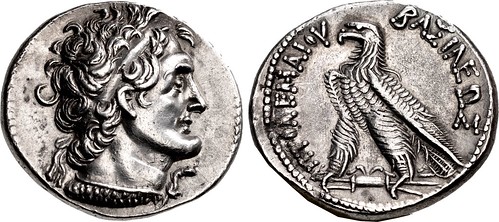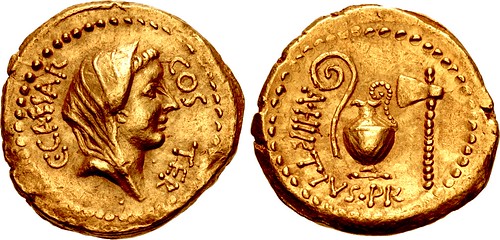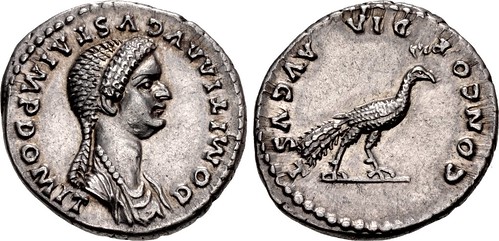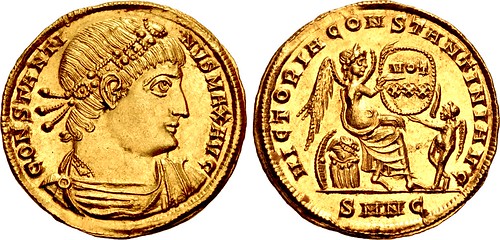
PREV ARTICLE
NEXT ARTICLE
FULL ISSUE
PREV FULL ISSUE
CLASSICAL NUMISMATIC GROUP SALE 112Here's the press release for the CNG fall sale. Some great coins here. -Editor An Internet and Mail Bid Sale Closing Electronically on Wednesday, 11 September 2019, from 10 AM ET Classical Numismatic Group is proud to present CNG 112, an Internet and Mail Bid Sale closing electronically on Wednesday, 11 September 2019, from 10 AM ET (U.S.). This sale offers 856 lots with a presale estimate of $1.95 million. Our annual fall sale features Greek, Celtic, Oriental Greek, Central Asian, Roman Provincial, Roman Republican, and Roman Imperial coinage. Additionally, there are featured selections of Byzantine, Early Medieval, Islamic, World, British coinage and British medals. CNG 112 is highlighted by a number of collections and individual rarities, which make up the majority of coins on offer:
Catalogs for CNG 112 have been mailed to our active mailing list and bidding is open on the site. Some of the individual highlights from CNG 112 are:  Lot 30 – CALABRIA, Tarentum. Circa 280-272 BC. AR Nomos (20.5mm, 6.52 g, 5h). Reduced standard. Nude youth, crowning horse upon which he sits right;
FI?OKPA to left, monogram below / Phalanthos, nude, holding trident and small Nike, who crowns him, riding dolphin left; APISTO below. Vlasto 867; HN Italy
998. Attractively toned. Near EF. Well centered and a lovely example of the type.
From the Matthew Curtis Collection. Ex Vinchon (14 December 1999), lot 715. Published by Cahn  Lot 80 – SICILY, Naxos. Circa 460 BC. AR Tetradrachm (28mm, 17.23 g, 11h). Bearded head of Dionysos right, wearing tainia decorated with an ivy
branch / Silenos, nude and bearded, squatting facing, his head turned left, looking at a kantharos he is holding up in his right hand, and supporting himself
with his left hand on the ground to the lower right, his tail emerges from behind, and extends across the ground below; N-AXI-ON around; all within shallow
concave circle. Cahn 54.25 (this coin); HGC 2, 983; SNG ANS 515; SNG Fitzwilliam 1108; SNG Lloyd 1150 = Warren 271; SNG Lockett 840; Gulbenkian 230–1; Bement
418; Berlin 571; BMC 7–8; Boston MFA 302–3; Hunt IV 79; Jameson 673; Kraay & Hirmer 6; Locker-Lampson 79; de Luynes 1060; McClean 2466; Rhousopoulos 349;
Rizzo pl. XXVIII, 2; Weber 1466; (all from the same dies). Attractively toned, with much of the original find patina remaining, some minor scratches at the end
of Dionysos’ beard. Struck at an early die state, thus only a hint of die break that develops on the obverse is visible. EF. Well centered and struck. A
masterpiece of late Archaic art with exceptional composition.
Ex collection of Edmond Dresse de Lesbioles, Liege; Ars Classica XVII (3 October 1934), lot 174. Located on the eastern shore of Sicily in the shadow of Mt. Aitna, Naxos was the oldest of the Greek colonies on the island, founded in 735 BC by colonists from Chalkis in Euboia and Ionia. According to the historian Thucydides (1.100), Naxos established its own colony by founding Leontini in 730 BC, which was soon followed by the foundation of a second colony, Aitna, later known as Katane. Owing to the fertility of the surrounding volcanic soil of Mt. Aitna, Naxos developed an economy of viticulture, and along with Leontini and Katane, became very prosperous. This wealth attracted the attention of Syracuse, which subjugated Naxos in 476 BC, removing its citizens along with those of Katane to Leontini. Following the death of Hieron in 461 BC, the Naxians were able to return to their homes and refound their city. In commemoration, this issue of tetradrachms was struck (Carmen Arnold-Biuuchi, The Randazzo Hoard [1990], p. 29). Featuring Dionysos on the obverse and the satyr Silenos, the half-man, half goat follower of Dionysos, on the reverse, they are one of the most famous coin types minted in antiquity. A superb example of early classical art, while still retaining some of the typical elements of archaic art, these tetradrachms were struck from a single pair of dies. The artist, clearly a master die-engraver and arguably the finest of his time anywhere in the Greek world, is known today as the “Aitna Master”, after a unique tetradrachm of Aitna in the Bibliothèque royale de Belgique (for a discussion of the “Aitna Master” and his association with this tetradrachm of Naxos, see François de Callataÿ, "On the Style of the 'Aitna Master' from Eastern Sicily," Israel Museum Studies in Archaeology, Volume 3 [2004], pp. 43-52). While the head of Dionysos is exceptional in its modeling, the kneeling Silenos is even more striking for its mastery of anatomical techniques, including the foreshortening of the right leg. Here, the clearly inebriated Silenos is managing to balance himself, but the manner in which he peers at his cup adds a trace of naturalistic humor to the composition.  Lot 170 – EUBOIA, Karystos. Circa 300-250 BC. AR Stater (22.5mm, 7.48 g, 1h). Cow standing right, head left toward calf suckling left / Cock standing
right. Robinson, Carystus 24 (A3/P11); BCD Euboia 569; HGC 4, 1552. Old collection tone. VF. Well centered, good metal for issue.
From the Baldwin Maull Collection, purchased from Coin Galleries, 1960.  Lot 378 – PTOLEMAIC KINGS of EGYPT. Ptolemy VI Philometor. First sole reign, 180-170 BC. AR Tetradrachm (27.5mm, 14.11 g, 12h). Alexandreia mint.
Diademed head of Ptolemy I right, aegis around neck / Eagle standing left on thunderbolt; no control marks. Svoronos 1489; Olivier 4225–9 (obv. die D163); SNG
Copenhagen 262–8. Lightly toned, trace deposits, a couple light marks under tone. Near EF. High relief.
From the John L. Cowan Collection. Ex Gemini XIII (6 April 2017), lot 108.  Lot 551 – The Caesarians. Julius Caesar. Early 46 BC. AV Aureus (19.5mm, 8.22 g, 6h). Rome mint; A. Hirtius, praetor. Veiled female head (Vesta or
Pietas?) right; C • CAESAR COS TER around / Emblems of the augurate and pontificate: lituus, guttus, and securis; A • HIRTIVS • PR around
from lower left. Crawford 466/1; Molinari 83 (D3/R212); CRI 56; Calicó 36; Sydenham 1018; BMCRR Rome 4052; RBW 1635. Good VF, A few light marks and scratches.
Struck from an obverse die of fine style.
 Lot 603 – Nero. AD 54-68. AV Aureus (18mm, 7.36 g, 6h). Rome mint. Struck circa AD 66-67. IMP NERO CAES?R ?VGVSTVS, laureate head of Nero right /
SALVS in exergue, Salus, draped, seated left on ornamented throne, holding patera in right hand and resting left at side. RIC I 66; Calicó 445; BMCRE 94-5; BN
236; Biaggi 244-5; Jameson –; Mazzini 317. Some light hairline marks, boldy struck, with a deep reddish tone, typical of aurei from the Boscoreale hoard. Near
EF.
From a European collection formed prior to the First World War.  Lot 612 – Domitia. Augusta, AD 82-96. AR Denarius (18mm, 3.56 g, 6h). Rome mint. Struck under Domitian, AD 82-83. DOMITI? ?VGVST? IMP DOMIT, draped
bust right, wearing necklace, and hair massed high in front above forehead and knotted in long plait on neck / CONCOR DIA AVGVST, peacock standing right. RIC
II 151 (Domitian); RSC 2; BMCRE 61 (Domitian); BN 65-68 (Domitian); Jameson –; Mazzini 2. Lightly toned. Choice EF. Very rare and among the finest specimens
known. Magnificent portrait.
Ex Numismatica Ars Classica 94 (6 October 2016), lot 190; Goldberg 80 (3 June 2014), lot 3142; Nomos 2 (18 May 2010), lot 182.  Lot 661 – Constantine I. AD 307/310-337. AV Solidus (21mm, 4.45 g, 6h). Tricennalia issue. Nicomedia mint, 2nd officina. Struck AD 335.
CONSTANTI NVS MAX AVG, rosette-diademed, draped, and cuirassed bust right, viewed from front / VICTORIA CONSTANTINI AVG, Victory seated right on shield and
cuirass, holding wreath or shield enclosing VOT/ XXX in two lines; wreath supported from underneath by winged Genius standing left: SMNC. RIC VII 178; Alföldi
616; Depeyrot 44/2; Biaggi 2017 var. (officina); Jameson –; Mazzini 615/a var. (same). Lustrous, a few faint hairlines in the field on obverse, traces of
deposits. Superb EF. Exceptional strike from fresh dies.
Ex Dr. Klaus Berthold [“Friend of the Romans”] Collection (Munzen und Medaillen AG 92, 22 November 2002), lot 304; Munzen und Medaillen AG FPL 573 (March 1994), no. 53; Munzen &Medaillen AG FPL 566 (June 1993), no. 35; Numismatic Fine Arts XXIX (13 August 1992), lot 438. Constantine I “the Great” was one of only three Roman Emperors to ever celebrate a Tricennalia marking 30 years of rule, an event celebrated by the issuance of this gold solidus type from the mint of Nicomedia in AD 335. Constantine had completely revolutionized the Roman world during his long and eventful reign, reunifying the empire after decades of internal division, moving the imperial capital to his own city Constantinople (the renamed Byzantium), and, most importantly, changing Christianity from a small, persecuted sect to the most favored religion of a huge multinational state. Even the visual iconography of coinage saw radical change: Here Constantine adopts an elaborate jeweled diadem in place of the former simple wreath worn by Roman rulers, and his long, carefully arranged hair presages the coiffeurs of medieval kings to come. However, Constantine was at pains to show some adherence to Roman tradition: The figure of Victory accompanied by a small winged Genius on the reverse does show continuity with the pagan past.  Lot 771 – MEXICO, Colonial. Carlos IV. King of Spain, 1788-1808. AV 8 Escudos (37mm, 27.02 g, 12h). Ciudad de México (Mexico City) mint. Dated 1807
Mo TH. Armored and draped bust right / Crowned coat-of-arms within Collar of the Order of the Golden Fleece. BW 33.15; Calicó 1164; KM 159; Friedberg 43.
Toned, faint hairlines. VF.
From the G.W.K. Roberts Collection, purchased from S.L. Smith, December 1994.  Lot 818 – NORMAN. William I 'the Conqueror'. 1066-1087. AR Penny (19.5mm, 1.42 g, 8h). Profile/Cross Fleurée type (BMC i). London mint;
Eadwine, moneyer. Struck 1066-1068. + PILLEIIS REX ?I, crowned bust left; scepter before / + E?DPINE ON LVNDE, cross fleurée, with pellet-in-annulet at center.
SCBI 20 (Mack), 1348 (same dies); North 839; SCBC 1250. Toned. Good VF.
Ex Williams Collection; Stack’s ‘Special Offering of British Coins’ (8 April 1989), lot 742. Printed catalogs for CNG 112 are now available. To order the catalog, please call our U.S. office at (717) 390-9194. Catalogs have been mailed to customers on CNG’s active mailing list. Prospective bidders may also view the virtual catalogs at https://issuu.com/cngcoins/docs/cng_112. The sale can be viewed online at cngcoins.com, sixbid.com, and numisbids.com. In addition to our Internet &Mail Bid Sale 112, CNG will also feature over 900 lots from many of the same collections listed above in their Electronic Auction 452, closing one week later on Wednesday, 18 September 2019, from 10AM ET (U.S.). Bidding for CNG Electronic Auction 452 will begin on 4 September 2019. CNG is currently accepting consignments for future auctions sales. Please contact the firm for further details and consignment deadlines. For further details and any additional information, please contact CNG, LLC at: Classical Numismatic Group, LLC

Wayne Homren, Editor The Numismatic Bibliomania Society is a non-profit organization promoting numismatic literature. See our web site at coinbooks.org. To submit items for publication in The E-Sylum, write to the Editor at this address: whomren@gmail.com To subscribe go to: https://my.binhost.com/lists/listinfo/esylum All Rights Reserved. NBS Home Page Contact the NBS webmaster 
|